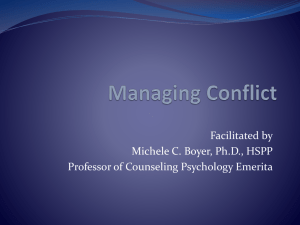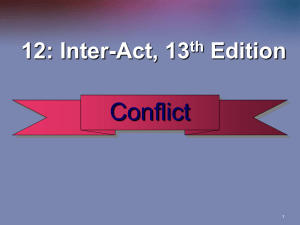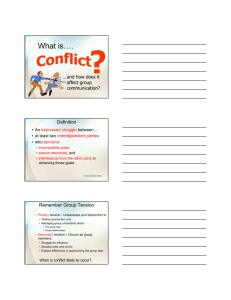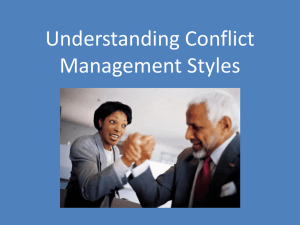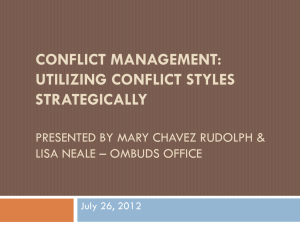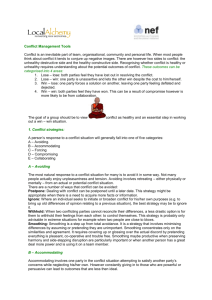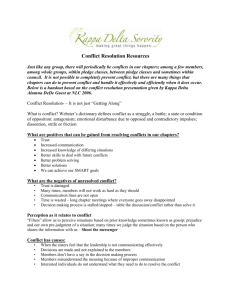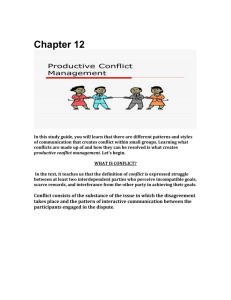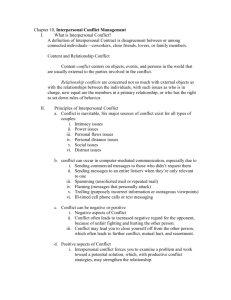Understanding Conflict Handling Styles
advertisement
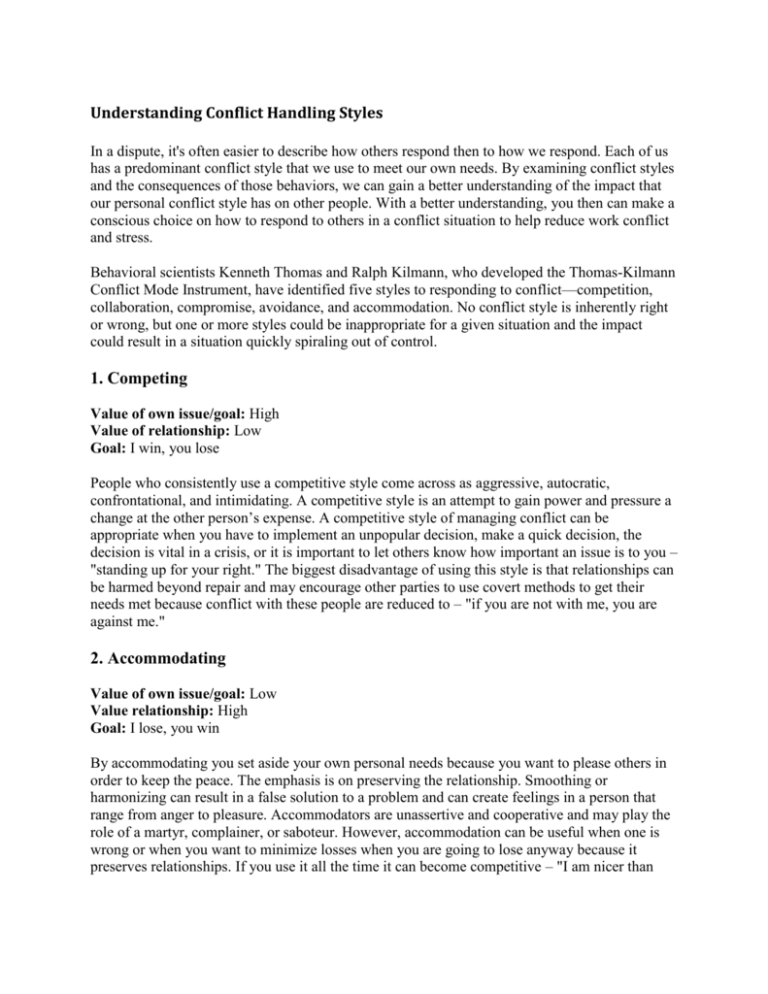
Understanding Conflict Handling Styles In a dispute, it's often easier to describe how others respond then to how we respond. Each of us has a predominant conflict style that we use to meet our own needs. By examining conflict styles and the consequences of those behaviors, we can gain a better understanding of the impact that our personal conflict style has on other people. With a better understanding, you then can make a conscious choice on how to respond to others in a conflict situation to help reduce work conflict and stress. Behavioral scientists Kenneth Thomas and Ralph Kilmann, who developed the Thomas-Kilmann Conflict Mode Instrument, have identified five styles to responding to conflict—competition, collaboration, compromise, avoidance, and accommodation. No conflict style is inherently right or wrong, but one or more styles could be inappropriate for a given situation and the impact could result in a situation quickly spiraling out of control. 1. Competing Value of own issue/goal: High Value of relationship: Low Goal: I win, you lose People who consistently use a competitive style come across as aggressive, autocratic, confrontational, and intimidating. A competitive style is an attempt to gain power and pressure a change at the other person’s expense. A competitive style of managing conflict can be appropriate when you have to implement an unpopular decision, make a quick decision, the decision is vital in a crisis, or it is important to let others know how important an issue is to you – "standing up for your right." The biggest disadvantage of using this style is that relationships can be harmed beyond repair and may encourage other parties to use covert methods to get their needs met because conflict with these people are reduced to – "if you are not with me, you are against me." 2. Accommodating Value of own issue/goal: Low Value relationship: High Goal: I lose, you win By accommodating you set aside your own personal needs because you want to please others in order to keep the peace. The emphasis is on preserving the relationship. Smoothing or harmonizing can result in a false solution to a problem and can create feelings in a person that range from anger to pleasure. Accommodators are unassertive and cooperative and may play the role of a martyr, complainer, or saboteur. However, accommodation can be useful when one is wrong or when you want to minimize losses when you are going to lose anyway because it preserves relationships. If you use it all the time it can become competitive – "I am nicer than you are" – and may result in reduced creativity in conflict situations and increased power imbalances. 3. Avoiding Value of own issue/goal: Low Value of relationship: Low Goal: I lose, you lose Avoidance is characterized by deliberately ignoring or withdrawing from a conflict rather than facing it. This style may be perceived as not caring about your own issue or the issues of others. People who avoid the situation hope the problem will go away, resolve itself without their involvement, or think that others are ready to take the responsibility. There are situations where avoidance is appropriate such as when you need more time to think of how to respond, time constraints demand a delay, confrontation will hurt a working relationship, or there is little chance of satisfying your needs. However, avoidance can be destructive if the other person perceives that you don’t care enough to engage. By not dealing with the conflict, this style allows the conflict to simmer and heat up unnecessarily, resulting in anger or a negative outburst. 4. Compromising Value of own issue/goal: Medium Value of relationship: Medium Goal: I win some, you win some The compromising style demonstrates that you are willing to sacrifice some of your goals while persuading others to give up part of theirs – give a little, get a little. Compromising maintains the relationship and can take less time than collaboration and resolutions might mean splitting the difference or seeking a middle ground position. The downside to compromising is that it can be an easy way out and reduces new creative options. If you constantly split the difference or “straddle the fence,” game playing can result and the outcome could be less than ideal. 5. Collaborating Value of own issue/goal: High Value of relationship: High Goal: I win, you win The collaborative style views conflicts as problems to be solved and finding creative solutions that satisfy all the parties’ concerns. You don’t give up your self interest; you dig into the issue to identify the underlying concerns, test your own assumptions, and understand the views of others. Collaboration takes time and if the relationship among the parties is not important, then it may not be worth the time and energy to create a win-win solution. However, collaboration fosters respect, trust, and builds relationships. To make an environment more collaborative, address the conflict directly and in a way that expresses willingness for all parties to get what they need. Although all of the approaches have their time and place, you need to ask yourself the basic question, "Is my preferred conflict handling style the very best I can use to resolve this conflict or solve this problem?" Focus on Interests (Needs), Not Positions (Wants) Understanding people's interests is not a simple task because we tend to communicate our positions – things that are likely to be concrete and explicit. It is helpful to learn to recognize the difference between person’s positions and interests to assist in creative problem solving. Positions are predetermined solutions or demands that people use to describe what they want – what the person wants to happen on a particular issue. For example: "I want the report." Interests define the problem and may be intangible, unexpressed, or not consistent. They are the main reasons why you say what you want – the motivation behind the position. The conflict is usually between each person's needs, desire, concern, or fear. For example: "I need to receive the report by Friday, so I can have time to review and edit before the due date next Wednesday." Remember that figuring out your interests is just as important as figuring out their interests. How to Identify Interests To identify interests of the other person, you need to ask questions to determine what the person believes he or she truly needs. When you ask, be sure to clarify that you are not asking questions for justification of their position, but for a better understanding of their needs, fears, hopes, and desires. Using open-ended questions that encourage a person to "tell their story" helps you begin to understand their interest. Open ended questions are opposite of closed-ended questions, which require a response of "yes" or "no." To illustrate the difference, consider the following example: Did you have a good relationship with your supervisor? (closed-ended) Tell me about your relationship with your supervisor. (open-ended) Examples of open-ended questions: What’s your basic concern about …? Tell me about … What do you think about …? How could we fix …? What would happen if …? How else could you do …? What could you tell me about …? Then what? Could you help me understand …? What do you think you will lose if you …? What have you tried before? What do you want to do next? How can I be of help? The most powerful interests for you to consider are the basic human needs for security, economic well-being, sense of belonging to an organization, identify, recognition of contribution or efforts, and autonomy or control over decisions or work. It is not uncommon for you or the other person to have multiple interests and it would be helpful for you to write them down as they occur to help you sort them out. This list may be helpful to think through ideas that may meet these interests. Problem solving on your interests and the other person’s interests leads to more creative and successful resolutions because you meet not only your need but theirs as well. Source: Fisher, Ury, and Patton, Getting to Yes, 1991
